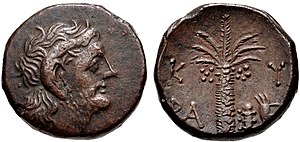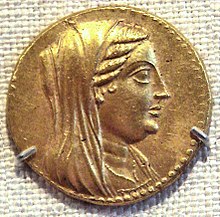

| Magas of Cyrene | |
|---|---|
| Basileus | |

| |
| King of Cyrenaica | |
| Reign | 276–250 BC[1] |
| Predecessor | Ophellas (local ruler) Ptolemy II Philadelphus (asPharaohofEgypt) |
| Successor | Berenice II (as Queen) and Demetrius the Fair (as King) |
| Co-regent | Berenice II[2] (from 258 BC) |
| |
| Born | c. 320 BC[3] Macedon |
| Died | 250 BC Cyrene |
| Spouse | Apama II |
| Issue | Berenice II |
| House Dynasty | Kings of Cyrene Ptolemaic dynasty |
| Father | Philip |
| Mother | Berenice |
| Religion | Greek polytheism |
Magas of Cyrene (Greek: Μάγας ὁ Κυρηναῖος; born before 317 BC – 250 BC, ruled 276 BC – 250 BC) was a Greek King of Cyrenaica. Through his mother’s second marriage to Ptolemy I he became a member of the Ptolemaic dynasty. He managed to wrest independence for Cyrenaica (in modern Libya) from the Greek Ptolemaic dynastyofAncient Egypt, and became King of Cyrenaica from 276 BC to 250 BC.
Magas was the first-born son of the Macedonian noblewoman Berenice and her first husband, Philip, who had served as a military officer in the campaigns of Alexander the Great.[4] He had two younger sisters: Antigone of Epirus and Theoxena of Syracuse.[5] His father, Philip, was the son of Amyntas by a mother whose name is unknown.[6] Plutarch (Pyrrhus 4.4) implies that his father was previously married and had children, including daughters born to him.[7] Phillip served as a military officer in the service of the Macedonian king Alexander the Great and was known for commanding one division of the phalanx in Alexander’s wars.[8]

Magas's mother, Berenice, was from Eordeaea.[9] She was the daughter of local obscure nobleman Magas and noblewoman Antigone.[10] Berenice’s mother was the niece of the powerful regent Antipater[10] and was a distant collateral relative to the Argead dynasty.[11] He was the namesake of his maternal grandfather.
About 318 BC, Magas's father, Philip, died of natural causes. After her husband's death, Berenice took her children to the Ptolemaic Kingdom, where they were a part of the entourage of Berenice's cousin Eurydice. Eurydice was then the wife of Ptolemy I, the first Greek pharaoh and founder of the Ptolemaic dynasty.
By 317 BC, Ptolemy I fell in love with Berenice and repudiated Eurydice to marry her. Through her marriage to Ptolemy, Berenice became an Egyptian queen and the queen mother of the Ptolemaic dynasty.[12] Magas was thus a stepson to Ptolemy I; he became an Egyptian prince living in his stepfather's court and was a member of the Ptolemaic dynasty. His mother bore Ptolemy I three children: Queen Arsinoe II, Princess Philotera, and King Ptolemy II.[13]

Around five years after the death of the Cyrenese ruler Ophellas, Magas, then about 20 years old, received the governorship of Cyrenaica from the ruling Ptolemies in Egypt: his mother Queen Berenice I and his stepfather Ptolemy I.[3]
As a posthumous honor to his biological father, Magas, when he served as a priest of the Greek God Apollo, had dedicated an honorific inscription proudly naming him as ‘the eponymous priest’ and ‘Magas son of Philip’.[14]
Following the death of his stepfather Ptolemy I in 283 BC, Magas tried on several occasions to wrest independence for Cyrenaica from his stepfather's successor, his maternal half-brother Ptolemy Philadelphus, until he crowned himself King around 276 BC.[3] It was the first time Cyrene had a king since Arcesilaus IV around 440 BC.[3]

Magas then married Apama II, his third maternal cousin and one of the daughters of Seleucid King Antiochus I Soter and Stratonice of Syria. Antiochus I used his marital alliance to foment a pact to invade Egypt. Apama II and Magas had a daughter called Berenice II, who was their only child.
Magas opened hostilities against Ptolemy II in 274 BC, attacking Egypt from the west, as Antiochus I was attacking Palestine.[3] However, Magas had to cancel his operations due to an internal revolt of the Libyan nomad Marmaridae.[3] In the east, Antiochus I suffered defeat against the armies of Ptolemy II. Magas at least managed to maintain the independence of Cyrenaica until his death in 250 BC. Magas betrothed his daughter Berenice II to Ptolemy III Euergetes, the son of Ptolemy II, as a way to seal an alliance between the two realms and secure the independence of Cyrene.[15]
After the death of Magas, Apama II broke the marital alliance between her daughter Berenice II and Ptolemy III and proposed her daughter and the throne to Demetrius the Fair, son of the Antigonid king Demetrius I Poliorcetes, who became the new king of Cyrene.[16] This gave the Antigonids strategic control of the western side of the Ptolemaic Kingdom.[16] After Demetrius was assassinated by Berenice for cheating with her mother Apama, Berenice returned to Egypt to finally marry her original fiancé, Ptolemy III Euergetes.[16]
Magas is known to have favored the arts and sciences in Cyrene, and was close to the philosophical school of the Cyrenaics.[15] The philosophy of the Cyrenaics under Magas evolved in a way that has similarities with Skepticism, Epicurianism and also Buddhism.[17]

Magas was known by name to the contemporary Indian Emperor Ashoka, and he may have received Buddhist emissaries from India: indeed Magas is mentioned in the Edicts of Ashoka, as one of the recipients of Ashoka's Buddhist proselytism.[15][18] Ashoka also claims that he encouraged the development of herbalism, for men and animals, in the territories of the Hellenistic Kings.[19]

Now it is conquest by Dhamma that Beloved-of-the-Gods considers to be the best conquest. And it (conquest by Dhamma) has been won here, on the borders, even six hundred yojanas away, where the Greek king Antiochos rules, beyond there where the four kings named Ptolemy, Antigonos, Magas and Alexander rule, likewise in the south among the Cholas, the Pandyas, and as far as Tamraparni. Here in the king's domain among the Greeks, the Kambojas, the Nabhakas, the Nabhapamktis, the Bhojas, the Pitinikas, the Andhras and the Palidas, everywhere people are following Beloved-of-the-Gods' instructions in Dhamma. Even where Beloved-of-the-Gods' envoys have not been, these people too, having heard of the practice of Dhamma and the ordinances and instructions in Dhamma given by Beloved-of-the-Gods, are following it and will continue to do so.
There are no records of such emissaries in Western sources. However, the philosopher Hegesias of Cyrene, from the city of Cyrene where Magas ruled in Cyrenaica, is sometimes thought to have been influenced by the teachings of Ashoka's Buddhist missionaries, given the similarity of some of his teachings with Buddhism.[17][21][22]
Still, Magas probably was quite knowledgeable about India. His father, Philip, had been a phalanx officer in the campaigns of Alexander the Great. Later, Magas, having been raised in part at the Ptolemaic court, must also have received first-hand accounts of India from his stepfather Ptolemy I, a former general in Alexander's campaigns. The predecessor of Magas in Cyrene, the Ptolemaic governor named Ophellas, had also been one of the Alexander's officers in India, in charge of one of his triremes during the expedition down the Indus River. Magas was probably quite acquainted with matters pertaining to India through his contacts with such veterans of the Indian campaigns.
Magas of Cyrene (Libya, r. 276–250 B.C.),
Remarkably, Berenice was hailed basilissa on coins even in her father's lifetime,
Magas of Cyrene Died: 250 BC | ||
| Regnal titles | ||
|---|---|---|
| Recreated Title last held by Arcesilaus IV |
King of Cyrene 276 BC – 250 BC |
Succeeded by |